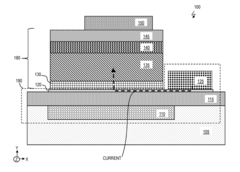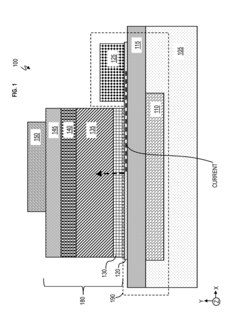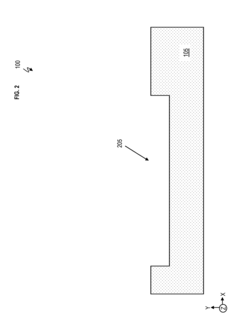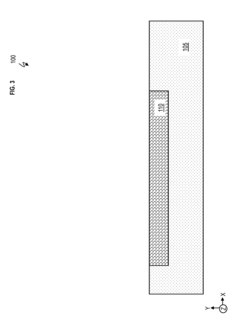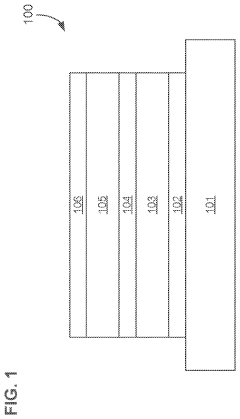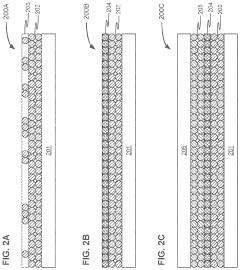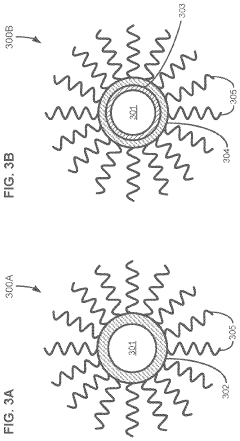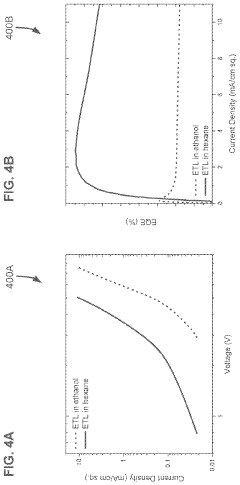Insights Into the Next Generation of QLED Technologies
JUN 20, 20259 MIN READ
Generate Your Research Report Instantly with AI Agent
Patsnap Eureka helps you evaluate technical feasibility & market potential.
QLED Evolution and Objectives
Quantum dot light-emitting diode (QLED) technology has emerged as a promising advancement in display technology, offering enhanced color accuracy, brightness, and energy efficiency compared to traditional LED displays. The evolution of QLED technology can be traced back to the discovery of quantum dots in the 1980s, with significant progress made in the past decade towards commercialization and widespread adoption.
The primary objective of QLED technology development is to create displays that offer superior visual performance while maintaining cost-effectiveness and energy efficiency. This includes achieving wider color gamuts, higher peak brightness, improved contrast ratios, and longer lifespans compared to existing display technologies such as OLED and LCD.
One of the key milestones in QLED evolution was the introduction of cadmium-free quantum dots, addressing environmental concerns and regulatory requirements. This breakthrough has paved the way for broader adoption of QLED technology in consumer electronics and professional displays.
The next generation of QLED technologies aims to overcome current limitations and push the boundaries of display performance. Key objectives include improving quantum dot efficiency, enhancing color purity, and developing novel quantum dot materials that can emit light directly when electrically excited, known as electroluminescent quantum dots.
Researchers are also focusing on developing quantum dot-based blue light-emitting materials, which have been a challenge due to the inherent difficulty in producing stable and efficient blue quantum dots. Achieving this would enable the creation of full-color QLED displays without the need for color filters, potentially leading to even higher efficiency and brightness.
Another important goal is to improve the stability and longevity of QLED displays, particularly in terms of maintaining color accuracy and brightness over extended periods of use. This involves developing more robust quantum dot materials and optimizing device architectures to minimize degradation mechanisms.
The integration of QLED technology with flexible and transparent substrates is another area of active research, aiming to enable new form factors and applications in wearable devices, automotive displays, and smart windows. This requires overcoming challenges related to quantum dot deposition and encapsulation on non-traditional substrates.
As QLED technology continues to evolve, there is also a focus on developing more sustainable and environmentally friendly manufacturing processes. This includes exploring bio-inspired quantum dot synthesis methods and investigating the use of recyclable materials in QLED display production.
The primary objective of QLED technology development is to create displays that offer superior visual performance while maintaining cost-effectiveness and energy efficiency. This includes achieving wider color gamuts, higher peak brightness, improved contrast ratios, and longer lifespans compared to existing display technologies such as OLED and LCD.
One of the key milestones in QLED evolution was the introduction of cadmium-free quantum dots, addressing environmental concerns and regulatory requirements. This breakthrough has paved the way for broader adoption of QLED technology in consumer electronics and professional displays.
The next generation of QLED technologies aims to overcome current limitations and push the boundaries of display performance. Key objectives include improving quantum dot efficiency, enhancing color purity, and developing novel quantum dot materials that can emit light directly when electrically excited, known as electroluminescent quantum dots.
Researchers are also focusing on developing quantum dot-based blue light-emitting materials, which have been a challenge due to the inherent difficulty in producing stable and efficient blue quantum dots. Achieving this would enable the creation of full-color QLED displays without the need for color filters, potentially leading to even higher efficiency and brightness.
Another important goal is to improve the stability and longevity of QLED displays, particularly in terms of maintaining color accuracy and brightness over extended periods of use. This involves developing more robust quantum dot materials and optimizing device architectures to minimize degradation mechanisms.
The integration of QLED technology with flexible and transparent substrates is another area of active research, aiming to enable new form factors and applications in wearable devices, automotive displays, and smart windows. This requires overcoming challenges related to quantum dot deposition and encapsulation on non-traditional substrates.
As QLED technology continues to evolve, there is also a focus on developing more sustainable and environmentally friendly manufacturing processes. This includes exploring bio-inspired quantum dot synthesis methods and investigating the use of recyclable materials in QLED display production.
Display Market Dynamics
The display market has witnessed significant growth and transformation in recent years, driven by technological advancements and changing consumer preferences. QLED (Quantum Dot Light Emitting Diode) technology has emerged as a key player in this evolving landscape, offering enhanced color reproduction, brightness, and energy efficiency compared to traditional LED displays.
The global display market is experiencing robust growth, with a particular emphasis on high-quality, large-format displays for both consumer and commercial applications. QLED technology has gained substantial traction in this space, particularly in the premium television segment. Major manufacturers have invested heavily in QLED research and development, recognizing its potential to deliver superior image quality and compete with OLED (Organic Light Emitting Diode) technology.
Consumer demand for larger screen sizes and higher resolutions has been a significant driver in the display market. QLED technology has positioned itself well to meet these demands, offering excellent performance in large-format displays while maintaining competitive pricing compared to OLED alternatives. This has led to increased adoption in the high-end television market, with QLED TVs capturing a growing market share.
The commercial display sector has also shown interest in QLED technology, particularly for applications requiring high brightness and color accuracy, such as digital signage and professional monitors. The ability of QLED displays to maintain color performance over extended periods has made them attractive for these use cases.
Market dynamics are further influenced by the ongoing competition between QLED and OLED technologies. While OLED has traditionally been considered superior in terms of contrast and viewing angles, advancements in QLED technology have narrowed this gap. The cost-effectiveness of QLED production compared to OLED has also contributed to its market growth.
Environmental concerns and energy efficiency regulations have become increasingly important factors in the display market. QLED technology's improved energy efficiency compared to traditional LED displays has positioned it favorably in this context, aligning with both consumer preferences and regulatory requirements.
The COVID-19 pandemic has had a notable impact on the display market, initially causing supply chain disruptions but subsequently driving increased demand for home entertainment systems and remote work setups. This shift has benefited QLED technology, as consumers seek high-quality displays for both work and leisure activities at home.
The global display market is experiencing robust growth, with a particular emphasis on high-quality, large-format displays for both consumer and commercial applications. QLED technology has gained substantial traction in this space, particularly in the premium television segment. Major manufacturers have invested heavily in QLED research and development, recognizing its potential to deliver superior image quality and compete with OLED (Organic Light Emitting Diode) technology.
Consumer demand for larger screen sizes and higher resolutions has been a significant driver in the display market. QLED technology has positioned itself well to meet these demands, offering excellent performance in large-format displays while maintaining competitive pricing compared to OLED alternatives. This has led to increased adoption in the high-end television market, with QLED TVs capturing a growing market share.
The commercial display sector has also shown interest in QLED technology, particularly for applications requiring high brightness and color accuracy, such as digital signage and professional monitors. The ability of QLED displays to maintain color performance over extended periods has made them attractive for these use cases.
Market dynamics are further influenced by the ongoing competition between QLED and OLED technologies. While OLED has traditionally been considered superior in terms of contrast and viewing angles, advancements in QLED technology have narrowed this gap. The cost-effectiveness of QLED production compared to OLED has also contributed to its market growth.
Environmental concerns and energy efficiency regulations have become increasingly important factors in the display market. QLED technology's improved energy efficiency compared to traditional LED displays has positioned it favorably in this context, aligning with both consumer preferences and regulatory requirements.
The COVID-19 pandemic has had a notable impact on the display market, initially causing supply chain disruptions but subsequently driving increased demand for home entertainment systems and remote work setups. This shift has benefited QLED technology, as consumers seek high-quality displays for both work and leisure activities at home.
QLED Technical Hurdles
QLED technology, while promising, faces several significant technical hurdles that need to be addressed for its widespread adoption and further advancement. One of the primary challenges is the stability and longevity of quantum dots. These nanocrystals are prone to degradation when exposed to air, moisture, and high temperatures, which can lead to a decrease in luminescence efficiency and color purity over time. This issue is particularly critical for blue quantum dots, which are essential for achieving a full-color display but tend to be less stable than their red and green counterparts.
Another major hurdle is the efficiency of charge injection and transport within QLED devices. The interface between the quantum dot layer and the charge transport layers often suffers from energy level mismatches, leading to inefficient charge injection and increased non-radiative recombination. This results in reduced overall device efficiency and potentially shorter lifespans. Improving the charge balance and developing more effective charge transport materials are crucial areas of research.
The manufacturing process for QLEDs also presents significant challenges. Current methods for depositing quantum dots onto substrates, such as spin-coating or inkjet printing, can lead to non-uniform layers and potential defects. Achieving precise control over quantum dot placement and orientation is critical for optimizing device performance and ensuring consistency across large-scale production. Additionally, the integration of quantum dot layers with other components of the display stack, such as electrodes and encapsulation layers, requires careful engineering to maintain the integrity and performance of the quantum dots.
Color accuracy and gamut remain areas of ongoing development. While QLEDs offer excellent color reproduction capabilities, achieving consistent and accurate colors across different viewing angles and maintaining color stability over the device's lifetime are still challenging. This is particularly important for high-end display applications where color fidelity is crucial.
Lastly, the environmental impact and toxicity of quantum dot materials pose both technical and regulatory challenges. Many current quantum dot formulations contain heavy metals like cadmium, which are toxic and subject to regulatory restrictions. Developing cadmium-free quantum dots that maintain high performance is a key focus area, as is improving the overall sustainability and recyclability of QLED devices.
Addressing these technical hurdles requires interdisciplinary research efforts, combining advances in materials science, device physics, and manufacturing processes. Overcoming these challenges will be crucial for realizing the full potential of QLED technology and establishing its position as a leading display technology in the coming years.
Another major hurdle is the efficiency of charge injection and transport within QLED devices. The interface between the quantum dot layer and the charge transport layers often suffers from energy level mismatches, leading to inefficient charge injection and increased non-radiative recombination. This results in reduced overall device efficiency and potentially shorter lifespans. Improving the charge balance and developing more effective charge transport materials are crucial areas of research.
The manufacturing process for QLEDs also presents significant challenges. Current methods for depositing quantum dots onto substrates, such as spin-coating or inkjet printing, can lead to non-uniform layers and potential defects. Achieving precise control over quantum dot placement and orientation is critical for optimizing device performance and ensuring consistency across large-scale production. Additionally, the integration of quantum dot layers with other components of the display stack, such as electrodes and encapsulation layers, requires careful engineering to maintain the integrity and performance of the quantum dots.
Color accuracy and gamut remain areas of ongoing development. While QLEDs offer excellent color reproduction capabilities, achieving consistent and accurate colors across different viewing angles and maintaining color stability over the device's lifetime are still challenging. This is particularly important for high-end display applications where color fidelity is crucial.
Lastly, the environmental impact and toxicity of quantum dot materials pose both technical and regulatory challenges. Many current quantum dot formulations contain heavy metals like cadmium, which are toxic and subject to regulatory restrictions. Developing cadmium-free quantum dots that maintain high performance is a key focus area, as is improving the overall sustainability and recyclability of QLED devices.
Addressing these technical hurdles requires interdisciplinary research efforts, combining advances in materials science, device physics, and manufacturing processes. Overcoming these challenges will be crucial for realizing the full potential of QLED technology and establishing its position as a leading display technology in the coming years.
Current QLED Architectures
01 QLED structure and materials
QLED technology involves the use of quantum dots as light-emitting materials. The structure typically includes layers of quantum dots sandwiched between electron and hole transport layers. Various materials and compositions are used to optimize the performance of QLEDs, including different types of quantum dots and charge transport materials.- QLED structure and materials: QLED technology involves the use of quantum dots as light-emitting materials. The structure typically includes layers of quantum dots sandwiched between electron and hole transport layers. Various materials and compositions are used to optimize the performance of these layers, including the quantum dot emissive layer, charge transport layers, and electrodes.
- Quantum dot synthesis and processing: The synthesis and processing of quantum dots are crucial for QLED performance. This includes methods for producing quantum dots with specific sizes, compositions, and surface treatments. Techniques for incorporating quantum dots into device structures, such as solution processing or transfer printing, are also important aspects of QLED technology.
- Color conversion and light management: QLED technology often involves color conversion, where blue or UV light is converted to other colors using quantum dots. This includes the development of color filters, light management structures, and optical designs to enhance color purity, brightness, and efficiency of QLED displays or lighting devices.
- QLED device fabrication and manufacturing: This aspect covers the manufacturing processes and techniques used to produce QLED devices at scale. It includes methods for depositing and patterning quantum dot layers, electrode formation, encapsulation, and integration with driving circuits. Innovations in this area aim to improve yield, reduce costs, and enhance device reliability.
- QLED performance enhancement: Various strategies are employed to enhance QLED performance, including improving quantum yield, reducing efficiency roll-off at high currents, enhancing color purity, and increasing device lifetime. This may involve novel quantum dot compositions, interface engineering, doping strategies, or the use of additional functional layers in the device structure.
02 Quantum dot synthesis and processing
The synthesis and processing of quantum dots are crucial for QLED performance. This includes methods for producing quantum dots with specific sizes and compositions, as well as techniques for incorporating them into device structures. Surface treatments and ligand exchange processes are often employed to enhance the properties of quantum dots for QLED applications.Expand Specific Solutions03 QLED device fabrication techniques
Various fabrication techniques are used in QLED production, including solution processing, inkjet printing, and vacuum deposition methods. These techniques aim to create uniform and defect-free layers of quantum dots and other materials. Innovations in manufacturing processes focus on improving device efficiency, stability, and scalability for commercial production.Expand Specific Solutions04 Color tuning and light management in QLEDs
QLED technology allows for precise color tuning through the control of quantum dot size and composition. Advanced light management techniques, such as the use of optical microcavities and photonic crystals, are employed to enhance light extraction and color purity. These approaches aim to improve the overall display performance and color gamut of QLED devices.Expand Specific Solutions05 QLED integration and applications
QLED technology is being integrated into various display and lighting applications. This includes the development of flexible and transparent QLED displays, as well as their incorporation into next-generation televisions, monitors, and mobile devices. Research is also focused on expanding QLED applications beyond displays, such as in solid-state lighting and sensors.Expand Specific Solutions
QLED Industry Leaders
The next generation of QLED technologies is entering a dynamic phase of development, characterized by rapid advancements and growing market potential. The industry is transitioning from early-stage research to commercial applications, with the global QLED market expected to expand significantly in the coming years. Technological maturity varies among key players, with companies like BOE Technology Group, Sharp Corp., and IBM leading in innovation. Chinese firms such as Guangdong Juhua Printing Display Technology and Shenzhen China Star Optoelectronics are making substantial progress, while academic institutions like MIT and Zhejiang University contribute cutting-edge research. The competitive landscape is diverse, featuring established electronics giants, emerging startups, and collaborative efforts between industry and academia, driving the evolution of QLED technology towards enhanced efficiency, color accuracy, and durability.
BOE Technology Group Co., Ltd.
Technical Solution: BOE has developed advanced QLED technology using quantum dot materials to enhance color gamut and brightness. Their next-generation QLED displays incorporate a new quantum dot synthesis method that improves the stability and efficiency of blue light conversion. BOE has also implemented a unique quantum dot color filter structure that allows for better light utilization and reduced power consumption. Additionally, they are exploring the use of perovskite quantum dots to further improve color purity and expand the color gamut.
Strengths: Large-scale production capabilities, strong R&D in display technologies. Weaknesses: Fierce competition in the QLED market, potential challenges in securing rare earth materials for quantum dots.
Sharp Corp.
Technical Solution: Sharp's next-generation QLED technology focuses on improving quantum dot efficiency and stability. They have developed a proprietary quantum dot encapsulation technique that enhances durability and prevents oxidation, leading to longer-lasting displays. Sharp is also working on integrating quantum dots with micro-LED technology to create ultra-high resolution displays with superior brightness and contrast. Their research includes the development of cadmium-free quantum dots to address environmental concerns and comply with stricter regulations.
Strengths: Strong brand recognition, expertise in display technologies. Weaknesses: Relatively smaller market share compared to some competitors, potential higher production costs for advanced QLED technologies.
Key QLED Patents Analysis
Vertically integrated nanotube and quantum dot LED for active matrix display
PatentActiveUS20180205031A1
Innovation
- A vertically integrated device structure using a semiconducting nanotube thin film as the anode for QDLEDs, where the nanotube film is transparent and its conductivity is tuned by an embedded local gate to control the drive current, allowing for effective pixel control and integration into an active matrix display.
Light-emitting apparatus with improved charge transport layer
PatentPendingUS20240237387A9
Innovation
- Incorporating a metal-oxide nanoparticle-based electron transport layer with specific solvent polarity and size characteristics, deposited using solution processes like spin coating or inkjet printing, to improve charge balance and injection efficiency in QLEDs.
Environmental Impact of QLEDs
The environmental impact of Quantum Dot Light Emitting Diodes (QLEDs) is a crucial consideration as this technology continues to evolve and gain prominence in the display industry. QLEDs offer several environmental advantages over traditional display technologies, particularly in terms of energy efficiency and longevity.
One of the primary environmental benefits of QLEDs is their superior energy efficiency compared to conventional LED and OLED displays. QLEDs can produce brighter and more vibrant colors while consuming less power, which translates to reduced energy consumption over the lifetime of the device. This efficiency not only lowers electricity costs for consumers but also contributes to a decrease in overall carbon emissions associated with display technology usage.
The manufacturing process of QLEDs also presents some environmental considerations. While the production of quantum dots involves the use of certain heavy metals, ongoing research is focused on developing more environmentally friendly alternatives. Recent advancements have led to the creation of cadmium-free quantum dots, addressing concerns about the potential environmental impact of this toxic element.
Durability and longevity are additional factors that contribute to the environmental profile of QLEDs. These displays typically have longer lifespans compared to other technologies, which means fewer replacements and less electronic waste over time. The extended lifespan of QLED devices can significantly reduce the environmental burden associated with the production, transportation, and disposal of display units.
End-of-life considerations for QLEDs are an important aspect of their environmental impact. The recyclability of QLED components is an area of ongoing research and development. While some materials used in QLEDs can be recycled, the complex nature of these devices presents challenges in terms of efficient and cost-effective recycling processes.
As QLED technology continues to advance, there is a growing focus on improving its overall environmental footprint. This includes efforts to enhance energy efficiency further, develop more sustainable manufacturing processes, and improve the recyclability of QLED components. The industry is also exploring the use of bio-based materials in QLED production, which could potentially reduce the reliance on non-renewable resources.
The environmental impact of QLEDs extends beyond the devices themselves to their applications. For instance, the use of QLEDs in smart lighting systems can contribute to energy savings in buildings and cities, potentially leading to significant reductions in energy consumption and associated greenhouse gas emissions on a larger scale.
One of the primary environmental benefits of QLEDs is their superior energy efficiency compared to conventional LED and OLED displays. QLEDs can produce brighter and more vibrant colors while consuming less power, which translates to reduced energy consumption over the lifetime of the device. This efficiency not only lowers electricity costs for consumers but also contributes to a decrease in overall carbon emissions associated with display technology usage.
The manufacturing process of QLEDs also presents some environmental considerations. While the production of quantum dots involves the use of certain heavy metals, ongoing research is focused on developing more environmentally friendly alternatives. Recent advancements have led to the creation of cadmium-free quantum dots, addressing concerns about the potential environmental impact of this toxic element.
Durability and longevity are additional factors that contribute to the environmental profile of QLEDs. These displays typically have longer lifespans compared to other technologies, which means fewer replacements and less electronic waste over time. The extended lifespan of QLED devices can significantly reduce the environmental burden associated with the production, transportation, and disposal of display units.
End-of-life considerations for QLEDs are an important aspect of their environmental impact. The recyclability of QLED components is an area of ongoing research and development. While some materials used in QLEDs can be recycled, the complex nature of these devices presents challenges in terms of efficient and cost-effective recycling processes.
As QLED technology continues to advance, there is a growing focus on improving its overall environmental footprint. This includes efforts to enhance energy efficiency further, develop more sustainable manufacturing processes, and improve the recyclability of QLED components. The industry is also exploring the use of bio-based materials in QLED production, which could potentially reduce the reliance on non-renewable resources.
The environmental impact of QLEDs extends beyond the devices themselves to their applications. For instance, the use of QLEDs in smart lighting systems can contribute to energy savings in buildings and cities, potentially leading to significant reductions in energy consumption and associated greenhouse gas emissions on a larger scale.
QLED vs. OLED Comparison
QLED (Quantum Dot Light Emitting Diode) and OLED (Organic Light Emitting Diode) are two leading display technologies that have been competing for dominance in the high-end television and display market. Both offer superior picture quality compared to traditional LED-LCD displays, but they achieve this through different mechanisms and have distinct advantages and disadvantages.
QLED technology, pioneered by Samsung, utilizes quantum dots to enhance color and brightness in LCD displays. These nano-sized semiconductor particles emit light of specific wavelengths when excited by electricity, resulting in more vibrant and accurate colors. QLED displays typically offer higher peak brightness levels, making them ideal for well-lit environments and HDR content. They also tend to have a longer lifespan and are less susceptible to burn-in issues compared to OLED.
On the other hand, OLED technology, championed by LG, uses organic compounds that emit light when an electric current is applied. Each pixel in an OLED display can be individually lit or turned off, resulting in perfect blacks and infinite contrast ratios. This ability to control each pixel independently allows for superior dark scene performance and wider viewing angles compared to QLED displays.
In terms of color accuracy, both technologies can produce a wide color gamut, but OLED generally offers more precise color reproduction due to its self-emissive nature. However, QLED displays have made significant strides in color accuracy with recent advancements in quantum dot technology.
Energy efficiency is another area of comparison. OLED displays are generally more energy-efficient when displaying darker content, as they can turn off individual pixels completely. QLED displays, being backlit, consume more power overall but can be more efficient when displaying bright content.
Manufacturing costs and scalability also differ between the two technologies. QLED displays are typically less expensive to produce at larger sizes, which has contributed to their popularity in the large-screen TV market. OLED manufacturing, while improving, still faces challenges in scaling up to larger sizes cost-effectively.
As both technologies continue to evolve, the gap between their performance characteristics is narrowing. The next generation of QLED displays aims to address some of the technology's limitations, such as improving viewing angles and local dimming capabilities. Meanwhile, OLED technology is focusing on increasing brightness levels and addressing potential burn-in issues.
The choice between QLED and OLED ultimately depends on specific use cases and personal preferences. QLED excels in bright environments and offers excellent value for large screen sizes, while OLED provides unparalleled contrast and viewing angles, making it ideal for home theater setups and professional color-critical work.
QLED technology, pioneered by Samsung, utilizes quantum dots to enhance color and brightness in LCD displays. These nano-sized semiconductor particles emit light of specific wavelengths when excited by electricity, resulting in more vibrant and accurate colors. QLED displays typically offer higher peak brightness levels, making them ideal for well-lit environments and HDR content. They also tend to have a longer lifespan and are less susceptible to burn-in issues compared to OLED.
On the other hand, OLED technology, championed by LG, uses organic compounds that emit light when an electric current is applied. Each pixel in an OLED display can be individually lit or turned off, resulting in perfect blacks and infinite contrast ratios. This ability to control each pixel independently allows for superior dark scene performance and wider viewing angles compared to QLED displays.
In terms of color accuracy, both technologies can produce a wide color gamut, but OLED generally offers more precise color reproduction due to its self-emissive nature. However, QLED displays have made significant strides in color accuracy with recent advancements in quantum dot technology.
Energy efficiency is another area of comparison. OLED displays are generally more energy-efficient when displaying darker content, as they can turn off individual pixels completely. QLED displays, being backlit, consume more power overall but can be more efficient when displaying bright content.
Manufacturing costs and scalability also differ between the two technologies. QLED displays are typically less expensive to produce at larger sizes, which has contributed to their popularity in the large-screen TV market. OLED manufacturing, while improving, still faces challenges in scaling up to larger sizes cost-effectively.
As both technologies continue to evolve, the gap between their performance characteristics is narrowing. The next generation of QLED displays aims to address some of the technology's limitations, such as improving viewing angles and local dimming capabilities. Meanwhile, OLED technology is focusing on increasing brightness levels and addressing potential burn-in issues.
The choice between QLED and OLED ultimately depends on specific use cases and personal preferences. QLED excels in bright environments and offers excellent value for large screen sizes, while OLED provides unparalleled contrast and viewing angles, making it ideal for home theater setups and professional color-critical work.
Unlock deeper insights with Patsnap Eureka Quick Research — get a full tech report to explore trends and direct your research. Try now!
Generate Your Research Report Instantly with AI Agent
Supercharge your innovation with Patsnap Eureka AI Agent Platform!
